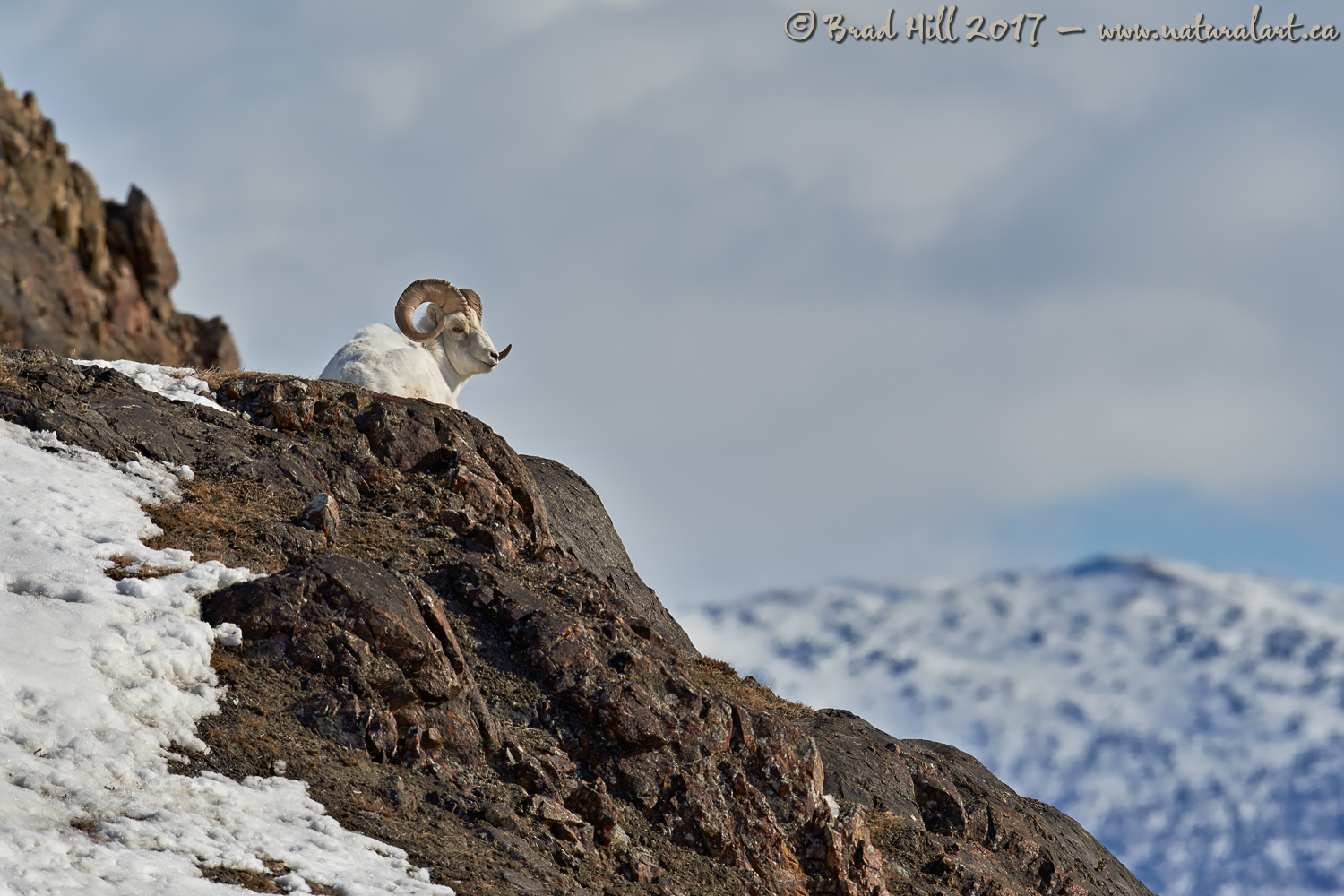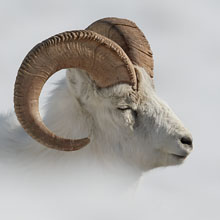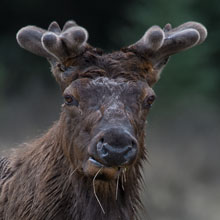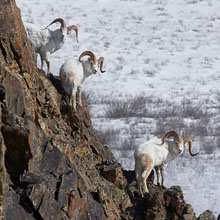Availability: Undetermined - Enquiries?
In the Field
Just Chillin'. Southwest Yukon Territory, Canada. April 1, 2017.
If one enjoys shooting animalscapes it's pretty hard for me to NOT recommend packing up your gear and heading up to the Yukon! Owing to the high latitudes, coldish temperatures, and (in some locations) high winds, the mountainous regions of Yukon are often devoid of those pesky subject-obscuring trees! We had spotted this Dall ram from literally kilometers away and, to my amazement, he stayed in position for over an hour as we worked our way into position to photograph him. Of course, for what seemed to be an eternity he wanted to look AWAY from both the sun and our position - apparently something on the distant mountain in the lower right corner of this shot was far more interesting than us. But, patience paid off and eventually he looked in the EXACT direction I was hoping he would (and right when the sun peeked through thin cloud to nicely illuminate his impressive horns)! Luck or persistence? Probably a little of both!
Over the winter of 2016/2017 I spent a lot of time testing and comparing the latest Sigma and Nikkor 500mm lenses. One aspect of my testing may seem odd to some - it involves assessing sharpness of scenes/subjects at moderate and long distances. You know, situations where the subject is still small in the scene even when shot at 500mm or even 750mm (like this sheep was shot at when I combined my Sigma 500 with a D500). Because the Sigma lens was several thousand dollars cheaper than the Nikkor lens I was afraid there might be some situations (such as when shooting relatively distant scenes) where it was optically weaker than the Nikkor. I was happy to find out that WASN'T the case...and now the more I use the Sigma 500mm f4 Sport in the field the more my confidence in it grows!
Here's a larger (2400 pixel) version of this chilled out ram...
• Just Chillin': Download 2400 pixel image (JPEG: 0.9 MB)
ADDITIONAL NOTES:
1. This image - in all resolutions - is protected by copyright. I'm fine with personal uses of them (including use as desktop backgrounds or screensavers on your own computer), but unauthorized commercial use of the image is prohibited by law. Thanks in advance for respecting my copyright!
2. Like all wildlife photographs on this website, this image was captured following the strict ethical guidelines described in The Wildlife FIRST! Principles of Photographer Conduct. I encourage all wildlife photographers to always put the welfare of their subjects above the value of their photographs.
Behind the Camera
Just Chillin'. Southwest Yukon Territory, Canada. April 1, 2017.
Digital Capture; Compressed RAW (NEF) 14-bit format; ISO 100.
Nikon D500 paired with Sigma 500mm f4 Sport lens. Supported on Really Right Stuff TVC-24 tripod with an Acratech Long Lens Head. OS on and in "OS1" mode, with OS1 stabilization customized to Moderate View mode; AF customized to Fast Priority AF.
1/1000s @ f7.1; +0.3 stop compensation from "recommended" matrix-metered exposure setting.
At the Computer
Just Chillin'. Southwest Yukon Territory, Canada. April 1, 2017.
RAW Conversion to 16-bit TIFF using Phase One's Capture One Pro 10. Three raw variants (different versions of a single raw capture) processed, with the variants differing in exposure settings (0.5 stop total difference between the variants) and highlight retrieval settings.
Further digital corrections on resulting 16-bit TIFF files using Adobe's Photoshop CC 2017 and Light Crafts Lightzone. Photoshop adjustments included compositing (blending) of the three output files from the raw converter and final selective sharpening for web output. Final tone-tweaking performed using LightZone's "tonemapper" tool.
Conservation
Just Chillin'. Southwest Yukon Territory, Canada. April 1, 2017.
Species Status in Canada*: Not listed as of Special Concern, Threatened, or Endangered.
The Dall Sheep (Ovis dalli) is a species of sheep native to northwestern North America. They inhabit the subarctic mountain ranges of Alaska, the Yukon Territory, the MacKenzie Mounntains in the Northwest Territories, and both central and northern British Columbia. The more southern form is known as the Stone Sheep and is slaty brown in colour with some white patches on the rump on the inside of the hind legs. Dall sheep are found in comparatively dry country and tend to be found in a unique combination of open alpine ridges, meadows, and steep slopes with extremely rugged ground (usually referred to as escape terrain) in the immediate vicinity. This escape terrain allows the sheep to escape from predators that can't travel as fast as these sure-footed sheep. The primary predators of Dall sheep include wolves, coyotes, black and grizzly bears and, during the lambing season, both golden eagles and wolverines.
While not technically endangered in Canada this Stone Sheep was photographed in the southwest portion of the Yukon Territory - and in this region poorly regulated and poorly managed hunting has reduced many local populations by over 50% compared to historical levels. In some populations local extirpation is likely imminent if hunting practices are not radically changed or completely suspended.
*as determined by COSEWIC: The Committee on the Status of Endangered Wildlife in Canada

























